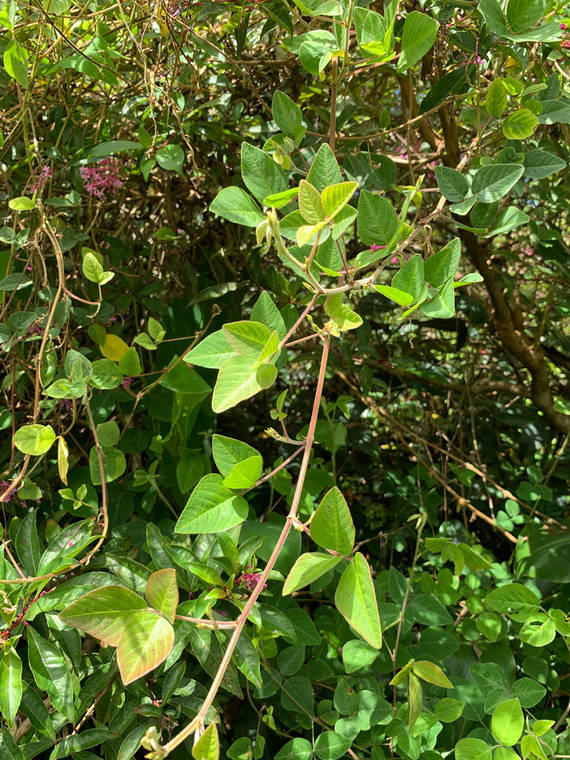Way back in 1995, a mysterious vine began popping up all over the lowlands of West Hawaii. It also showed up on Oahu about the same time. The University of Hawaii Agricultural Extension offices began to get calls that kudzu vine was sprouting up all over and covering shrubs and trees.
Our offices continued to get phone calls about the vine that was growing all over the forests around Kailua village and Windward Oahu. Even though the Outdoor Circle made concerted efforts to educate residents about the vine, there was still considerable misinformation as to what it was and what to do about it.
Since our recent heavy rains, we are again seeing the rapid outbreak of vines along roadsides and gardens. First of all, this is not kudzu. What we are seeing along our rural roadsides is actually a combination of vine species.
Much of it is the ivy gourd, or Coccinea grandis. It is a close relative of the cucumber. Other vines mixed in are several species of morning glory and Desmodium.
Desmodium species are related to kudzu and are nitrogen fixers. Desmodium species are a valuable food source for cattle, but when not grazed, the larger growing species can climb into shrubs and trees. You can observe Desmodium along the roadsides in Kaloko Mauka, where it is climbing 20-30 feet into the ohia and covering hapuu. It is easy to control by pulling the vine out by the roots.
Now, back to the ivy gourd.
As happened 20 years ago, the most rampant growth areas of ivy gourd are beginning to cover koa haole and kiawe along roadsides or where cattle are not grazing. In fact, these plants have been around for years, but grazing pressures and drier weather kept them from becoming a problem. This is much the same case as the banana poka vine that was rampant in some mauka areas of the Big Island and Kauai.
Although some folks see the ivy gourd as an ugly alien species, others see it as nature attempting to heal the wounds made by poor management or changes due to strange climatic extremes. But it is obvious the ivy gourd has become too much of a good thing and creative management is necessary.
The first thing is not to spread it to new areas or other islands. Remove it from your garden if it is present and support biological control efforts. Avoid indiscriminate insecticidal applications that might hinder the establishment of bio control insects.
The Department of Agriculture and University of Hawaii researchers looked for biological control. In the 1990s, they found a moth and two weevils that feed on the vine. The DOA evaluated these insects to make sure they fed only on the ivy gourd. Then there was a general release in areas where the vines were abundant.
After the release of these insects, the population of ivy gourd vines gradually diminished until it was rare to see plants — that is until recently. What happened to the insects? They are undoubtedly still here, but it will take time until their populations catch up to the food supply of vines.
In the meantime, put on your garden gloves and pull out unwanted vines in your garden.
Remember that the ivy gourd fruit and shoot tips are edible, medicinal and good for grazing animals. Even now, pharmaceutical companies canvas the Pacific Islands for plants of medicinal value, and this one has been studied as well.
We are learning more and more that we cannot simply label life forms as good guys and bad guys. Nature just is!
It is how we manage that makes the difference.
In individual gardens, the vine is relatively easy to control by hand weeding before it gets the upper hand. In that event, herbicides might be necessary.
Or we might just turn the tables on the ivy gourd and use it for food and medicine as older and possibly more mature cultures have done for thousands of years.






